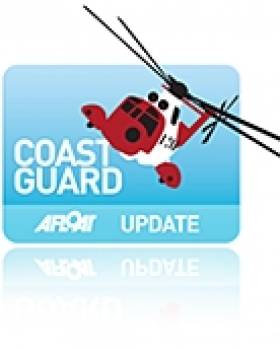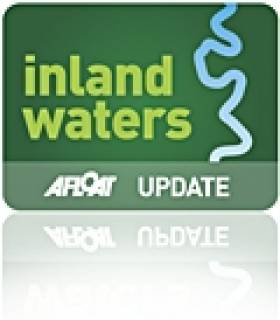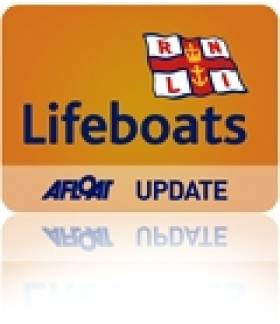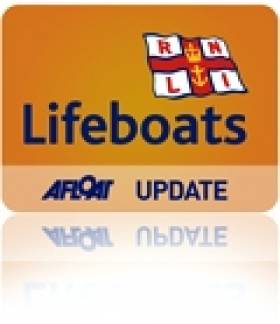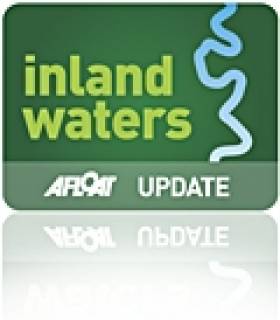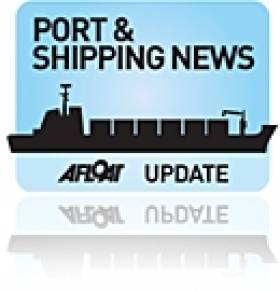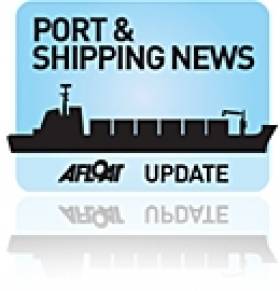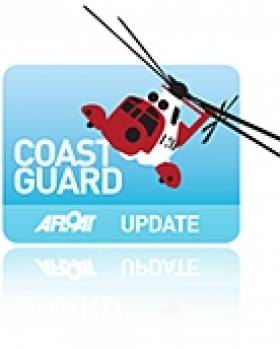Displaying items by tag: Coast Guard
False Alarm for Kitesurfer 'Pulled Out to Sea'
A number of local Search and Rescue Units were involved in the search for a Kite Surfer who was seen being pulled out to sea approximately 3 miles off Balaggan Point, Co Louth yesterday, according to SAR Ireland.
Full CH 67 Comms below.
Kilkeel, Greenore and later Clogher Head lifeboats were all involved along with a passing yacht as they raced in pursuit of what was thought to be an out of control Kite Surfer as he was spotted being pulled out across Dundalk Bay.
Clogher Head lifeboat eventually managed to catch up with the surfer who it turned out was being towed by a jetski, had a VHF handheld and was in no danger whatsoever.
All units were stood down and told to return to base.
Both Belfast and Dublin CG Co-ordinated at different intervals of this search.
Baltimore Lifeboat Rescues Man Overboard
Valentia Coast Guard alerted the Baltimore lifeboat station at 12:43pm and both the inshore lifeboat Bessie and the all-weather lifeboat Hilda Jarrett put to sea. The twin engined Atlantic 75 which has a top speed of 32 knots, reached the casualty within 20 minutes under the direction of Helmsman Youen Jacob.
Crewman Ronan Callanan administered oxygen to the stricken fisherman stabilising his condition, which had been serious due to long immersion in water. Further medical attention was offered by all weather lifeboat crewman Jerry Smith when it arrived on scene 20 minutes later.
Given the seriousness of the fishermans condition it was decided that an airlift was the most appropriate course of action and a rescue helicopter was called.
Helmsman Youne Jacob, commended the Captain and crew of the fishing boat in retrieving the fisherman from the water, which was made even more difficult by the choppy sea conditions prevailing.
The Inshore lifeboat then returned to Baltimore Harbour, However the allweather lifeboat remained at seas, as another distress call was received from a fishing vessel adrift 30 miles offshore.
In current weather conditions it will take them two hours to reach the vessel and several more to tow her back to shore.
Onboard the inshore lifeboat were Helmsman Youen Jacob, crewmen Ronan Callanan and Tadhg Collins.
On board the all weather lifeboat are coxswain Aidan Bushe, Cathal Cottrell, Jerry Smith, Ronnie Carty and father and son team Pat and Diarmuid Collins
60-foot Barge Sinks in Killaloe
Killaloe Coast Guard Unit was tasked to a 60' barge that was sinking at its mooring on Lough Derg on the inland waterways this afternoon. The Killaloe Coast Guard Unit dispatched two vehicles with crew and salvage pubs by road and the rescue boat "Dalton" was sent to place anti-pollution booms.
According to the Coastguard after many hours it was obvious that even with four pumps and a slurry tank the barge had sat on the bottom listing to starboard. A second slurry tank and the fire and rescue service from Nenagh also assisted.
11 Kayakers Rescued by Portrush Lifeboat
The callers stated that they could see a group of twelve kayakers in difficulty off Portballintrae, Causeway Coast, Northern Ireland.
Belfast Coastguard called out the Coleraine Coastguard Rescue Team and requested the launch of the Portrush RNLI lifeboats.
On arrival the Coleraine Coastguard Rescue team kept the kayakers under observation and directed the Portrush RNLI inshore lifeboat to the Kayakers. It was quickly established some of the group had become exhausted and suffering from sea sickness. Eleven of the group where transferred onto the large all weather Portrush Lifeboat whilst the Inshore Lifeboat escorted the one remaining kayaker back to Portballintrae Harbour.
The Portrush Lifeboat then transferred the eleven rescued kayakers who were mainly teenagers to the safety of Portrush Harbour.
Luckily none of the group required any medical attention.
Portrush lifeboat station adds:
Weather conditions were blustery and there was quite a swell off the coast. There was a North West wind coupled with a strong ebb tide. The tide was flowing against the wind, making conditions for the kayakers extremely difficult to return to shore. The Inshore Lifeboat (ILB) was launched first but it became clear the All-weather Lifeboat (ALB) was going to be needed to assist with the recovery of the party.
The ILB recovered 3 kayakers and returned them to Portballintrae. The ALB recovered the rest of the party and took them to Portrush Harbour.
The kayakers are safe and well, apart from suffering chronic sea sickness
Robin Cardwell Lifeboat Operations Manager said
'The fast response of the volunteer RNLI Lifeboat Crews from Portrush Station undoubtedly saved the lives of these kayakers. The sea and wind conditions made it virtually impossible for them to return to shore. Without the fast response of the crews at Portrush, this would have had a very different outcome'
Engine Failure on Lough Derg Leads to Lifeboat Rescue
At 15.49hrs on Sunday April 17 the Lough Derg RNLI Lifeboat was requested to launch by Valentia Coast Guard to assist five persons and their two dogs aboard a vessel adrift off Whitegate, on the County Clare side of Lough Derg. At 16.02 the lifeboat launched with helm Eleanor Hooker, Colin Knight and Ger Egan on board. The lake was calm with a light south-easterly wind, Force 2-3. Visibility was very good. The lifeboat came alongside the casualty vessel at 16.10hrs and found that all persons, four adults, one child and two dogs, were safe and unharmed. The casualty vessel had dropped anchor to prevent being pushed aground onto nearby rocks. With an RNLI crew member onboard, the cruiser was towed to the safety of the public harbour at Garrykennedy.
The skipper of the vessel thanked the crew of the lifeboat. He said 'I saw the lifeboat out training earlier this morning and never imagined you would be helping me in the afternoon. It's great to know you're there'.
The lifeboat returned to station and was ready for service again at 17.00hrs
Hire Cruiser Hits Killaloe Bridge
The Cruiser was holed and was taking on water.
Killaloe Coast Guard Mobile unit was tasked to Derg Marina with salvage pumps while the Coast Guard Rescue Boat also responded according to a Coast Guard blog report here.
It was decided that in order to save the vessel from sinking that the Coast Guard would run the cruiser aground in the shallow water at nearby Ballyvalley.
Coveney Welcomes Refloating of Ship at Rossaveal
Minister Coveney paid tribute to all those involved in what he described as "a very successful operation in very challenging conditions. Having visited Ros an Mhíl yesterday evening and spoken to those involved, including the Harbour Master and the Coast Guard, the scale of the challenge was evident, involving such a large vessel carrying a substantial fuel load. There was a very real threat to the marine environment and it is a testament to the professionalism of all those involved that such a threat was averted."
The Minister said that he was "glad to have had the opportunity to see at first hand the professionalism and competence of all the agencies involved, including the Harbour Master and his staff, the Irish Coast Guard, An Garda Siochana and Galway County Council." Minister Coveney also acknowledged the assistance and co-operation provided by the ship's representatives in reaching a successful conclusion to this incident.
Minister Coveney confirmed that "the incident would be thoroughly investigated by the Marine Casualty Investigation Board". The Minister said that "the vessel is now anchored off the north Clare coast where it is currently undergoing a detailed inspection. The vessel will continue to be monitored by the Irish Coast Guard on the AIS system (Automatic Identification System)."
Minister Coveney is meeting the Harbour Master and will be briefed by the various agencies who are involved in the operation, including the Irish Coast Guard, Galway County Council and the ship's representatives and will be given a full assessment of the current situation and the contingency arrangements being put in place by the agencies involved for the next few days.
The Minister said "I am anxious to see the situation for myself and to express my support to all involved in this multi-agency operation. While this is obviously a very serious and evolving situation, I have full confidence in the Harbour Master and his staff, the Coast Guard and the other agencies involved to do a fully professional job to address the current situation. The purpose of my visit is to reassure all those concerned that this incident is getting the priority it deserves. I am especially concerned to ensure that all appropriate measures are taken to protect the harbour and the local environment and to avoid any pollution during the very challenging efforts to refloat the vessel. "
The current situation and the weather forecast are being carefully monitored by the Coast Guard. Initial investigations, including evidence from divers, indicate no apparent damage to the vessel and no pollution has been reported. Meanwhile, the vessel's owners are in the process of organising tugs to help move it from its current position.
Wicklow Lifeboat Crew Race from Christening to Rescue
Both of the station lifeboats was launched and quickly located the kayakers South of Wicklow head , one man was taken on board the inshore lifeboat , he was then transferred onto the all-weather lifeboat and swiftly taken back to Wicklow harbour where he was met by a waiting ambulance crew and transferred to hospital for observation. The all-weather lifeboat then returned and picked up the other two men from the inshore lifeboat, they were landed safely in Wicklow harbour at 2-45pm and both lifeboats were stood down, allowing Coxswain Nick Keogh and David O Leary to re-join their families and resume the christening celebrations.
Lifeboat Operations manager Des Davitt said the 3 kayakers were well prepared and equipped with flares and vhf radio , 'they used their mobile marine VHF radio to contact the coast guard and ask for assistance, It meant our crew were able to respond quickly and bring them to safety'.
Related Safety posts
RNLI Lifeboats in Ireland
Safety News
Rescue News from RNLI Lifeboats in Ireland
Coast Guard News from Ireland
Water Safety News from Ireland
Marine Casualty Investigation Board News
Marine Warnings
Howth Coastguard and Lifeboat Rescue Teenager
The teenager had walked down a 100 foot steep cliff path to Jameson Beach on Howth Head with her friends when she collapsed. Gardai arrived on the scene and requested Coast Guard assistance to 'extract the female'.
The Howth Coast Guard Cliff Rescue Team were paged and arrived quickly at the scene. Medical care was given by the team, the casualty who was suffering from the cold was stabilised and placed in a stretcher for evacuation. Due to the terrain the quickest way to extract the casualty was via boat. Howth lifeboat quickly responded and the casualty was transferred back to the lifeboat station to a waiting ambulance.
The Coast Guard remind people that if they see someone who needs help on a beach to phone the new European wide emergency phone number, 112, and ask for the Coast Guard.


























